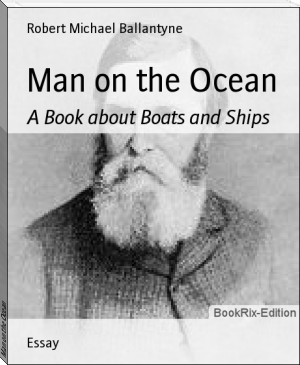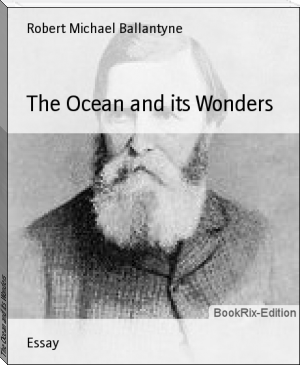Man on the Ocean by Robert Michael Ballantyne (web ebook reader TXT) 📕

- Author: Robert Michael Ballantyne
Book online «Man on the Ocean by Robert Michael Ballantyne (web ebook reader TXT) 📕». Author Robert Michael Ballantyne
The sails were made of linen in Homer's time; subsequently sail-cloth was made of hemp, rushes, and leather. Sails were sometimes dyed of various colours and with curious patterns. Huge ropes were fastened round the ships to bind them more firmly together, and the bulwarks were elevated beyond the frame of the vessels by wicker-work covered with skins.
Stones were used for anchors, and sometimes crates of small stones or sand; but these were not long of being superseded by iron anchors with teeth or flukes.
The Romans were not at first so strong in naval power as their neighbours, but in order to keep pace with them they were ultimately compelled to devote more attention to their navies. About 260 B.C. they raised a large fleet to carry on the war with Carthage. A Carthaginian quinquereme which happened to be wrecked on their coast was taken possession of by the Romans, used as a model, and one hundred and thirty ships constructed from it. These ships were all built, it is said, in six days; but this appears almost incredible. We must not, however, judge the power of the ancients by the standard of present times. It is well known that labour was cheap then, and we have recorded in history the completion of great works in marvellously short time, by the mere force of myriads of workmen.
The Romans not only succeeded in raising a considerable navy, but they proved themselves ingenious in the contrivance of novelties in their war-galleys. They erected towers on the decks, from the top of which their warriors fought as from the walls of a fortress. They also placed small cages or baskets on the top of their masts, in which a few men were placed to throw javelins down on the decks of the enemy; a practice which is still carried out in principle at the present day, men being placed in the "tops" of the masts of our men-of-war, whence they fire down on the enemy. It was a bullet from the "top" of one of the masts of the enemy that laid low our greatest naval hero, Lord Nelson.
From this time the Romans maintained a powerful navy. They crippled the maritime power of their African foes, and built a number of ships with six and even ten ranks of oars. The Romans became exceedingly fond of representations of sea-fights, and Julius Caesar dug a lake in the Campus Martius specially for these exhibitions. They were not by any means sham fights. The unfortunates who manned the ships on these occasions were captives or criminals, who fought as the gladiators did-- to the death--until one side was exterminated or spared by imperial clemency. In one of these battles no fewer than a hundred ships and nineteen thousand combatants were engaged!
Such were the people who invaded Britain in the year 55 B.C. under Julius Caesar, and such the vessels from which they landed upon our shores to give battle to the then savage natives of our country.
It is a curious fact that the crusades of the twelfth and thirteenth centuries were the chief cause of the advancement of navigation after the opening of the Christian era. During the first five hundred years after the birth of our Lord, nothing worthy of notice in the way of maritime enterprise or discovery occurred.
But about this time an event took place which caused the foundation of one of the most remarkable maritime cities in the world. In the year 476 Italy was invaded by the barbarians. One tribe, the Veneti, who dwelt upon the north-eastern shores of the Adriatic, escaped the invaders by fleeing for shelter to the marshes and sandy islets at the head of the gulf, whither their enemies could not follow by land, owing to the swampy nature of the ground, nor by sea, on account of the shallowness of the waters. The Veneti took to fishing, then to making salt, and finally to mercantile enterprises. They began to build, too, on those sandy isles, and soon their cities covered ninety islands, many of which were connected by bridges. And thus arose the far-famed city of the waters--"Beautiful Venice, the bride of the sea."
Soon the Venetians, and their neighbours the Genoese, monopolised the commerce of the Mediterranean.
The crusades now began, and for two centuries the Christian warred against the Turk in the name of Him who, they seem to have forgotten, if indeed the mass of them ever knew, is styled the Prince of Peace. One of the results of these crusades was that the Europeans engaged acquired a taste for Eastern luxuries, and the fleets of Venice and Genoa, Pisa and Florence, ere long crowded the Mediterranean, laden with jewels, silks, perfumes, spices, and such costly merchandise. The Normans, the Danes, and the Dutch also began to take active part in the naval enterprise thus fostered, and the navy of France was created under the auspices of Philip Augustus.
The result of all this was that there was a great moving, and, to some extent, commingling of the nations. The knowledge of arts and manufactures was interchanged, and of necessity the knowledge of various languages spread. The West began constantly to demand the products of the East, wealth began to increase, and the sum of human knowledge to extend.
Shortly after this era of opening commercial prosperity in the Mediterranean, the hardy Northmen performed deeds on the deep which outrival those of the great Columbus himself, and were undertaken many centuries before his day.
The Angles, the Saxons, and the Northmen inhabited the borders of the Baltic, the shores of the German Ocean, and the coasts of Norway. Like the nations on the shores of the Mediterranean, they too became famous navigators; but, unlike them, war and piracy were their chief objects of pursuit. Commerce was secondary.
In vessels resembling that of which the above is a representation, those nations went forth to plunder the dwellers in more favoured climes, and to establish the Anglo-Saxon dominion in England; and their celebrated King Alfred became the founder of the naval power of Britain, which was destined in future ages to rule the seas.
It was the Northmen who, in huge open boats, pushed off without chart or compass (for neither existed at that time) into the tempestuous northern seas, and, in the year 863, discovered the island of Iceland; in 983, the coast of Greenland; and, a few years later, those parts of the American coast now called Long Island, Rhode Island, Massachusetts, Nova Scotia, and Newfoundland. It is true they did not go forth with the scientific and commercial views of Columbus; neither did they give to the civilised world the benefit of their knowledge of those lands. But although their purpose was simply selfish, we cannot withhold our admiration of the bold, daring spirit displayed by those early navigators, under circumstances of the greatest possible disadvantage-- with undecked or half-decked boats, meagre supplies, no scientific knowledge or appliances, and the stars their only guide over the trackless waste of waters.
In the course of time, one or two adventurous travellers pushed into Asia, and men began to ascertain that the world was not the insignificant disc, or cylinder, or ball they had deemed it. Perhaps one of the chief among those adventurous travellers was Marco Polo, a Venetian, who lived in the latter part of the thirteenth century. He made known the central and eastern portions of Asia, Japan, the islands of the Indian Archipelago, part of the continent of Africa, and the island of Madagascar, and is considered the founder of the modern geography of Asia.
The adventures of this wonderful man were truly surprising, and although he undoubtedly exaggerated to some extent in his account of what he had seen, his narrations are for the most part truthful. He and his companions were absent on their voyages and travels twenty-one years.
Marco Polo died; but the knowledge of the East opened up by him, his adventures and his wealth, remained behind to stir up the energies of European nations. Yet there is no saying how long the world would have groped on in this twilight of knowledge, and mariners would have continued to "hug the shore" as in days gone by, had not an event occurred which at once revolutionised the science of navigation, and formed a new era in the history of mankind. This was the invention of the mariner's compass.
CHAPTER FIVE.
THE MARINER'S COMPASS--PORTUGUESE DISCOVERIES.
"What _is_ the compass?" every philosophical youth of inquiring disposition will naturally ask. We do not say that all youths will make this inquiry. Many there are who will at once say, "Oh, I know! It's a needle with a card on the top of it--sometimes a needle with a card under it--which always points to the north, and shows sailors how to steer their ships."
Very well explained indeed, my self-sufficient friend; but you have not answered the question. You have told us what a compass is like, and one of the uses to which it is applied; but you have not yet told what it _is_. A man who had never heard of a compass might exclaim, "What! a needle! Is it a darning needle, or a knitting needle, or a drawing-through needle? And which end points to the north--the eye or the point? And if you lay it on the table the wrong end to the north, will it turn round of its own accord?"
You laugh, perhaps, and explain; but it would have been better to have explained correctly at first. Thus:--
The mariner's compass is a small, flat bar of magnetised steel, which, when balanced on a pivot, turns one of its ends persistently towards the north pole--the other, of course, towards the south pole; and it does this in consequence of its being magnetised. A card is fixed above, sometimes below, this bar of steel (which is called the needle), whereon are marked the cardinal points--north, south, east, and west--with their subdivisions or intermediate points, by means of which the true direction of any point can be ascertained.
"Aha!" you exclaim, "Mr Author, but you yourself have omitted part of the explanation. _Why_ is it that the magnetising of the needle causes it to turn to the north?"
I answer humbly, "I cannot tell;" but, further, I assert confidently, "Neither can anybody else." The fact is known, and we see its result; but the reason why magnetised steel or iron should have this tendency, this polarity, is one of the mysteries which man has not yet been able to penetrate, and probably never will.
Having explained the nature of the compass, as far as explanation is possible, we present our reader with a picture of one.
It will be seen that there are four large points--N, S, E, and W--the cardinal points above referred to, and that these are subdivided by twelve smaller points, with one little black triangular point between each, and a multitude of smaller points round the outer circle. To give these points their correct names is called "boxing the compass,"--a lesson which all seamen can trip off their





Comments (0)